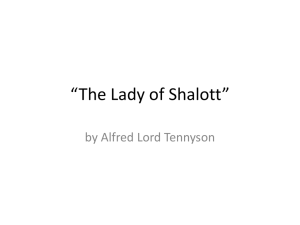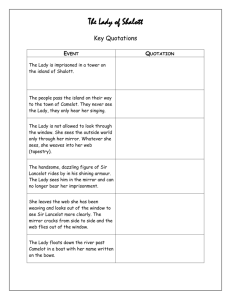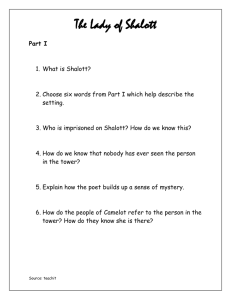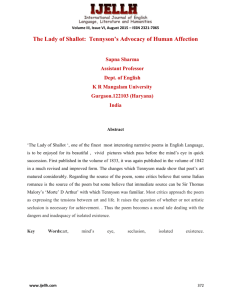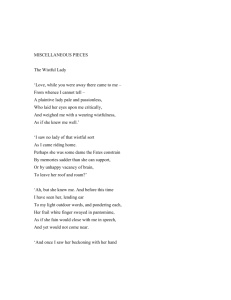5. Sports
advertisement
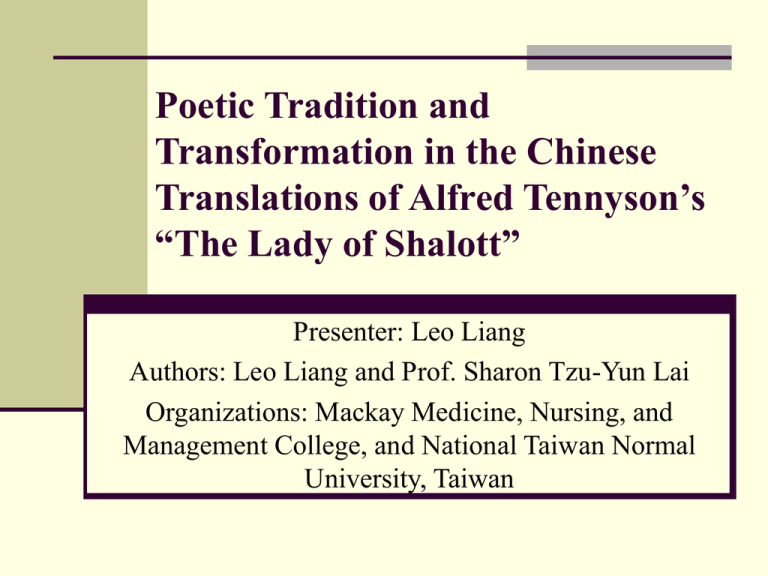
Poetic Tradition and Transformation in the Chinese Translations of Alfred Tennyson’s “The Lady of Shalott” Presenter: Leo Liang Authors: Leo Liang and Prof. Sharon Tzu-Yun Lai Organizations: Mackay Medicine, Nursing, and Management College, and National Taiwan Normal University, Taiwan Outline 1. Introduction 2. Characteristics of Lord Tennyson’s poems 3. Analysis of the poem “The Lady of Shallot” 4. Analysis of different Chinese translations of the poem 5. Conclusion 2007/12/13 2 Introduction Poetry and translation The main argument The loss and compensation in the translation are actually a culturally different representation of the poetic traditions and transformation. The method of analysis 2007/12/13 Examination of Chinese translations of Lord Tennyson’s poem, “The Lady of Shallot” 3 Characteristics of Lord Tennyson’s poems His superb ability to present images and sounds weave them together Critics’ comments 2007/12/13 Arthur Hallam T. S. Elliot John Hollander 4 Critics comments: Arthur Hallam “Thirdly, his vivid, picturesque delineation of objections, and the peculiar skill with which he holds all of them fused, to borrow a metaphor from science, in a medium of strong emotion.” “Fourthly, the variety of his lyrical measures, and exquisite modulation of harmonious words and cadences to the swell and fall of the feelings expressed.” 2007/12/13 5 Critics comments: T. S. Elliot “The finest ear of any English poet since Milton” “[Extending] very widely the range of active metrical forms in English” 2007/12/13 6 Critics comments: John Hollander “His poetic act is the association of the sound and sight, the rendering of the former not so much by direct pseudo-onomatopoeia in the sounds of words, but in the pattern we have been discerning, or a sound-rich description of a visual phenomenon which itself stands for an auditory one.” 2007/12/13 7 “The Lady of Shallot” Introduction Its structure The idea of “weaving” in the poem Meters and rhymes Other rhythmic devices 2007/12/13 Alliteration Onomatopoeia 8 “The Lady of Shallot”: the structure 1. The setting of Camelot and the island of Shalott. 2. The Lady of Shalott’s daily activity, weaving, and the curse on her. 3. The climax of the poem: the description of Lancelot, and Shalott’s breaking of curse. 4. The death of the Lady of Shalott. 2007/12/13 9 “The Lady of Shallot”: “weaving” Weaving as the Lady’s only activity Weaving as the process of Tennyson’s composition (Elaine Jordan) 2007/12/13 10 “The Lady of Shallot”: meters and rhymes The 1st part: 4 stanzas The 2nd part: 4 stanzas The 3rd part: 5 stanzas The 4th part: 6 stanzas Each stanza has 9 lines. 2007/12/13 11 “The Lady of Shallot”: meters and rhymes On either side the river lie Long fields of barley and of rye, That clothe the wold and meet the sky; And thro' the field the road runs by To many-tower'd Camelot; And up and down the people go, Gazing where the lilies blow Round an island there below, The island of Shalott. 2007/12/13 a a a a b c c c b 12 “The Lady of Shallot”: Other rhythmic devices Alliteration Onomatopoeia 2007/12/13 13 Discussions on translation of poetry John Dryden Vladimir Nabokov Andre Lefevere James Holmes 2007/12/13 14 Chinese translations of this poem 1 complete translation published in a book and 13 practices of translation assignment The loss caused by difficulties and problems: 2007/12/13 The title of the poem: The Lady of Shallot The format and rhyme scheme of the overall poem 15 The title of the poem: The Lady of Shallot The translation of “The Lady” The translation of “Shallot” The word order 2007/12/13 16 The format and rhyme scheme Among the 14 translations, the Chinese poetic traditions reflected in them include: Modern poetry/free verse: 11 Regulated verse form in 7 characters in a line: 2 “Fu” (written in 4-6 or 6-4 characters in a line): 1 2007/12/13 17 The format and rhyme scheme Modern poetry/free verse: an example from Liu 2007/12/13 18 The format and rhyme scheme Regulated verse form in 7 characters in a line: an example from Jiang 2007/12/13 19 The format and rhyme scheme “Fu” (written in 4-6 or 6-4 characters in a line): an example from Leo 2007/12/13 20 The format and rhyme scheme Some other efforts to follow the rhyme scheme: End rhymes in Liu’s translation Eight-character lines as the original tetrameters in Shannon, Amy, and Yvette’s translations an tian bian guo luo suo yo dao dao 2007/12/13 21 Conclusion Various translations demonstrate the wealthy and various Chinese poetic traditions, the loss of the important elements in the original poem is actually compensated by the culturally transformed characteristics in these translations. Robert Frost’s famous comment: “Poetry is what gets lost in translation.” But the real loss is not able to see that the translators have strived to shorten the distances between two cultures and that in their translations they offer the compensations rooted in their culture. 2007/12/13 22
